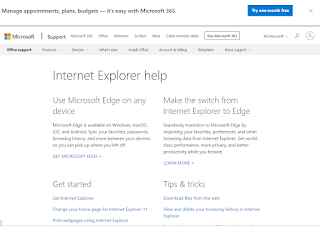Top 10 web Browsers List
1. Google Chrome
Google Chrome is a cross-platform web browser developed by Google. It was first released in 2008 for Microsoft Windows and was later ported to Linux, macOS, iOS, and Android where it is the default browser built into the OS.
The browser is also the main component of Chrome OS, which serves as the platform for web applications.
website URL:https://www.google.com/chrome/
Most of Chrome's source code comes from Google's free and open-source software project Chromium, but Chrome is licensed as proprietary freeware. WebKit was the original rendering engine, but Google eventually forked it to create the Blink engine; all Chrome variants except iOS now use Blink.[10]
As of November 2020, StatCounter estimates that Chrome has a 70% worldwide browser market share (after peaking at 72.38% in November 2018) on personal computers and 66.12% across all platforms. Because of this success, Google has expanded the "Chrome" brand name to other products: Chrome OS, Chromecast, Chromebook, Chromebit, Chromebox, and Chromebase.
2. Mozilla Firefox
Mozilla Firefox, or simply Firefox, is a free and open-source web browser developed by the Mozilla Foundation and its subsidiary, the Mozilla Corporation. Firefox uses the Gecko layout engine to render web pages, which implements current and anticipated web standards. In 2017, Firefox began incorporating new technology under the code name Quantum to promote parallelism and a more intuitive user interface.
Firefox is officially available for Windows 7 or newer, macOS, and Linux. Its unofficial ports are available for various Unix and Unix-like operating systems including FreeBSD, OpenBSD, NetBSD, illumos, and Solaris Unix. Firefox is also available for Android and iOS. However, the iOS version uses the WebKit layout engine instead of Gecko due to platform limitations, as with all other iOS web browsers.
An optimized version of Firefox is also available on the Amazon Fire TV, as one of the two main browsers available with Amazon's Silk Browser.
Firefox was created in 2002 under the codename "Phoenix" by the Mozilla community members who desired a standalone browser, rather than the Mozilla Application Suite bundle. During its beta phase, Firefox proved to be popular with its testers and was praised for its speed, security, and add-ons compared to Microsoft's then-dominant Internet Explorer 6. Firefox was released on November 9, 2004, and challenged Internet Explorer's dominance with 60 million downloads within nine months. Firefox is the spiritual successor of Netscape Navigator, as the Mozilla community was created by Netscape in 1998 before its acquisition by AOL.
Firefox usage grew to a peak of 32.21% at the end of 2009, with Firefox 3.5 overtaking Internet Explorer 7, although not all versions of Internet Explorer as a whole. Usage then declined in competition with Google Chrome. As of November 2020, according to StatCounter, Firefox has an 8.03% usage share as a "desktop" web browser, making it the third-most-popular web browser after Google Chrome (67.77%) and Safari (9.77%), its usage share across all platforms is lower at 3.82% (third-most-popular after Google Chrome with 63.58% and Safari with 19.19%), and according to NetMarketShare, Firefox has 8.02% usage share as a "desktop" web browser and 3.39% usage share across all platforms.
3. Opera Web Browser
Opera is a multi-platform web browser developed by Opera Software. Opera is a Chromium-based browser. It distinguishes itself from other browsers through its user interface, functionality, and other features.
Opera was initially released in April 1995, making it one of the oldest desktop web browsers still actively developed today. It was commercial software for the first ten years and had its own proprietary Presto layout engine. In 2013, Opera switched from the Presto engine to Chromium, opening up support for Chromium-based plug-ins.
The web browser can be used on Microsoft Windows, Android, iOS, macOS, and Linux operating systems. There are also three mobile versions: called Opera, Opera Touch, and Opera Mini. A gaming browser called Opera GX was launched on 11 June 2019.
4. Safari Web Browser
Safari is a graphical web browser developed by Apple, based on the WebKit engine. First released on the desktop in 2003 with Mac OS X Panther, a mobile version that has been bundled with iOS devices since the iPhone's introduction in 2007. Safari is the default browser on Apple devices. A Windows version was available from 2007 to 2012.
website URL:https://www.apple.com/safari/
5. Internet Explorer
Internet Explorer[a] (formerly Microsoft Internet Explorer[b] and Windows Internet Explorer, commonly abbreviated IE or MSIE) is a series of graphical web browsers developed by Microsoft and included in the Microsoft Windows line of operating systems, starting in 1995. It was first released as part of the add-on package Plus! for Windows 95 that year.
Later versions were available as free downloads, or in-service packs, and included in the original equipment manufacturer (OEM) service releases of Windows 95 and later versions of Windows. New feature development for the browser was discontinued in 2016 in favor of their new browser Microsoft Edge.
Since Internet Explorer is a Windows component and is included in long-term lifecycle versions of Windows such as Windows Server 2019, it will continue to receive security updates until at least 2029. Microsoft announced in August 2020 that as of August 2021, web-based Microsoft 365 products will no longer support Internet Explorer, with support for Microsoft Teams ending earlier in November 2020.
Internet Explorer was once the most widely used web browser, attaining a peak of about 95% usage share by 2003. This came after Microsoft used bundling to win the first browser war against Netscape, which was the dominant browser in the 1990s. Its usage share has since declined with the launch of Firefox (2004) and Google Chrome (2008), and with the growing popularity of operating systems such as Android and iOS that do not support Internet Explorer.
Estimates for Internet Explorer's market share are about 1.05% across all platforms, or by StatCounter's numbers ranked 8th. On traditional PCs, the only platform on which it has ever had a significant share, it is ranked 6th at 2.15%, after Microsoft Edge (and Opera), its successor. Edge first overtook Internet Explorer in terms of market share in November 2019. IE and Edge combined rank fourth, after Firefox, previously being second after Chrome.
Microsoft spent over US$100 million per year on Internet Explorer in the late 1990s, with over 1,000 people involved in the project by 1999.
6. Slimjet Browser
SlimBrowser is a tabbed multiple-site web browser from FlashPeak, Inc., an Austin, Texas-based company. It uses the Microsoft Trident layout engine.
It incorporates a large collection of features like built-in popup killer, skinned window frame, form filler, site group, quick-search, auto login, hidden sites, built-in commands and scripting, online translation, script error suppression, blacklist/whitelist filtering, URL Alias.
website URL:https://www.slimjet.com/
SlimBrowser was one of the twelve browser choices offered to European Economic Area users of Microsoft Windows in 2010.
Since V6.0, SlimBrowser has adopted a multi-process architecture to improve stability and eliminate performance restrictions associated with traditional single-process browsers. SlimBrowser included a full-featured form filler with the support of multiple identities in V6.01.
7. Maxthon Web Browser
Maxthon (Chinese: 傲游浏览器, formerly named MyIE2) is a freeware web browser developed by the company Maxthon Ltd., based in Beijing, China. It is available for Windows, macOS, Linux, and as Maxthon Mobile for Android, iOS,[10] and Windows Phone 8 As of version 3, Maxthon supports two web browser engines: WebKit and Trident.
Maxthon won CNET WebWare 100 Awards in 2008 and 2009 and was #97 in PC World's list of the 100 Best Products of 2011.
8. Slimbrowser Web Browser
SlimBrowser is a tabbed multiple-site web browser from FlashPeak, Inc., an Austin, Texas-based company. It uses the Microsoft Trident layout engine.
It incorporates a large collection of features like built-in popup killer, skinned window frame, form filler, site group, quick-search, auto login, hidden sites, built-in commands and scripting, online translation, script error suppression, blacklist/whitelist filtering, URL Alias.
SlimBrowser was one of the twelve browser choices offered to European Economic Area users of Microsoft Windows in 2010.
Since V6.0, SlimBrowser has adopted a multi-process architecture to improve stability and eliminate performance restrictions associated with traditional single-process browsers. SlimBrowser included a full-featured form filler with the support of multiple identities in V6.01.
FlashPeak has also released two SlimBrowser clones with different engines from Trident: The cross-platform Slimjet which uses Chromium and SlimBoat which used WebKit, but SlimBoat is no longer supported.
9. UC Web Browser
UC Browser is a web browser developed by mobile internet company UCWeb, a subsidiary of the Alibaba Group. It is one of the most popular mobile browsers in China and Indonesia and was the 8th most downloaded mobile app of the 2010–2019 decade.
Originally launched in April 2004 as a J2ME-only application, it is now available on several platforms including Android, iOS, BlackBerry OS, Java ME, Symbian, Windows Phone Microsoft Windows. It has been the subject of several security and privacy controversies and was banned in India on June 29, 2020, shortly after the 2020 China–India skirmishes.
10. Netscape Web Browser
The Netscape web browser is the general name for a series of web browsers formerly produced by Netscape Communications Corporation, a former subsidiary of AOL.
The original browser was once the dominant browser in terms of usage share, but as a result of the first browser war, it lost virtually all of its share to Internet Explorer.
Netscape was discontinued and support for all Netscape browsers and client products was terminated on March 1, 2008.








